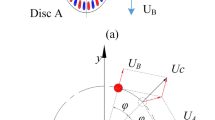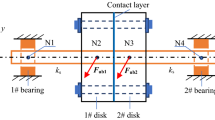Abstract
The rotor is the most important component of rotating machinery, and the vibration produced by its mass unbalance has a serious influence on the secure and steady operation of the machine, so an effective online suppression technology is urgently needed. A new hydraulic unbalanced bionic self-recovery system is introduced, imitating the way of manually repairing faulty equipment. To accomplish the effect of actuator mass redistribution, the technology employs pressurized air to drive the quantitative transfer of liquid in the reservoir cavity at opposite positions. It can complete the online adjustment of the equipment’s balancing state and suppress the unbalanced vibration of equipment in real time, which gives the equipment the ability to maintain an autonomous health state and improve equipment performance. The composition and working principle of the system are introduced in detail, and the key performance parameters, such as the minimum running speed and the balancing liquid transfer speed, are analyzed theoretically. The fluid–solid coupling model of the actuator was established, and the two-phase flow from inside the hydraulic unbalanced bionic self-recovery actuator was simulated under multiple working conditions and the performance parameters were quantitatively analyzed. A balancing simulation test bed was built, and its effectiveness was verified by performance parameter tests and unbalanced bionic self-recovery experiments. The experimental results show that the mass distribution adjustment of the balancing disk can be achieved using different viscosity balancing liquid, and the response of liquid viscosity 10 \(cS{\text{t}}\) is faster than that of liquid viscosity 100 \(cS{\text{t}}\) in the process of balancing liquid transfer, and the time is reduced by more than 75%; the system can reduce the simulated rotor amplitude from 18.3 μm to 10.6 μm online in real time, which provides technical support for the subsequent development of a new generation of bionic intelligent equipment.

















Similar content being viewed by others
Data Availability
All data generated or analyzed during this study are included in this article.
References
Yang, X. F., Zhang, H. K., Li, G. J., Fu, Z. Q., Tan, X. X., & Chen, L. (2023). Analysis method and application of rotor dynamic balance test for large hydropower units. Journal of Physics: Conference Series, 2491(1), 012027.
Yang, J. L., Yin, S. Y., & Gao, T. Y. (2021). An efficient method for imbalanced fault diagnosis of rotating machinery. Measurement Science and Technology, 32(11), 115025.
Su, J. J., Ding, D. J., Zhang, T. C., Sha, H., Han, J. H., & Yang, H. X. (2021). Application and advantages of on-site dynamic balancing technology to deal with rotor dynamic unbalance fault. Petroleum & Chemical Equipment, 24, 70–72 (in Chinese).
Lin, S. Q. (2021). Talking about the rotor dynamic balance technology. Guangdong Chemical Industry, 48, 122–124. in Chinese.
He, L. D., & Gao, J. J. (2003). A study of fault mechanisms in a rotor-seal system. Key Engineering Materials, 245–246, 399–406.
Gao, J. J. (2018). Bionic artifcial self-recovery and machine fault self-recovery system. Journal of Mechanical Engineering, 54(8), 83–94.
Zhang, Y., Sun, H., Hu, Z. B., & Mei, X. S. (2019). Behavior analysis and suppression strategy for unbalanced vibration in high-speed spindle system. Journal of Xi’an Jiaotong University, 53(05), 24–29+99 (in Chinese).
Su, X. W., & DeSmidt, H. (2023). Imbalance vibration suppression for asymmetric rotors via an enhanced automatic dynamic balancer. Journal of Sound and Vibration, 545, 117416.
Yun, X. L., Mei, X. S., Jiang, G. D., Hu, Z. B., & Zhang, Z. H. (2018). Investigation on a no trial weight spray online dynamic balancer. Shock and Vibration, 2018, 1–15.
Zhang, S. H., & Cai, Y. J. (2016). A new double-face online dynamic balance device and its control system for high speed machine tool spindle. Journal of Vibration and Control, 22(4), 1037–1048.
Pan, X., Wu, H. Q., Gao, J. J., & Wang, W. M. (2015). New liquid transfer active balancing system using compressed air for grinding machine. Journal of Vibration and Acoustics, 137(1), 11014.
Zhang, X. N., Liu, X., Zhang, W. W., & Xia, X. R. (2019). Control strategy and tests of balancing device for liquid injection and discharge type grinding wheel. Journal of vibration and shock, 38, 223–230 (in Chinese).
Pan, X., Xie, Z., Lu, J., Wu, H. Q., Gao, J. J., & Jiang, Z. N. (2019). Novel liquid transfer active balancing system for hollow rotors of high-speed rotating machinery. Applied Sciences, 9(5), 833.
Geng, G. Q. (2018). Application of centrifugal pump rotor dynamic balancing technique. Chemical Engineering Transactions (CET Journal), 66, 769–774.
Gao, J. J. (2022). Bionic artificial self-recovery enables autonomous health of machine. Journal of Bionic Engineering, 19, 1545–1561.
Zhan, W., & Feng, L. Z. (2017). Analysis on high-speed spindle online dynamic balancing regulation characteristics. Applied Mechanics and Materials, 868, 207–211.
Guo, Y. L., Yao, J. F., & Li, Y. (2023). Dynamic balancing of multispeed multi-disk rotor. Journal of Mechanical Science and Technology, 37(5), 1–12.
Pan, X., Lu, J. Q., Huo, J. J., Gao, J. J., & Wu, H. Q. (2020). A review on self-recovery regulation (sr) technique for unbalance vibration of high-end equipment. Chinese Journal of Mechanical Engineering, 33(1), 1–23.
Pan, X., Huo, J. J., Wu, H. Q., Li, W., Ge, D. H., Gao, J. J., & Jiang, Z. N. (2022). A kind of large-diameter hydraulic automatic self-recovery actuator. China: CN114576310B, 2022-10-04. (in Chinese).
Pan, X., Li, W., Ge, D. H., Gao, J. J., Jiang, Z. N., & Wu, H. Q. (2022). A kind of hydraulic large-diameter automatic self-recovery actuator. China: CN115355282A, 2022-11-18 (in Chinese).
Xu, H. Y., Yang, Y., Ma, H., Luo, Z., Li, X. P., Han, Q. K., & Wen, B. C. (2022). Vibration characteristics of bearing-rotor systems with inner ring dynamic misalignment. International Journal of Mechanical Sciences, 230, 107536.
Wang, H., Liu, L. Y., Zhu, C. Y., Ma, Y. G., & Fu, T. T. (2022). Stability and uniformity of gas–liquid two-phase flow in shear-thinning fluids in parallelized microchannels. Chemical Engineering Journal, 444, 136679.
Qiu, F. C., Wu, H., & Quan, X. J. (2018). Investigation of gas–liquid two-phase flow field behavior based on computational fluid dynamics in a water-sparged aerocyclone. Asia-Pacific Journal of Chemical Engineering, 13(6), e2252.
Nekhamin, M., Beztsennyi, I., Dunayevska, N., & Vyfatnuik, V. (2020). On using the ansys fluent software for calculating the process of burning a mixture of particles from different types of solid fuels. Eastern-European Journal of Enterprise Technologies, 4(8), 48–53.
Sun, X. F., & Zhao, Z. (2020). Simulation and analysis on flow field of ball valve based on fluent software. Journal of Physics: Conference Series, 1650(3), 032079.
Xie, J. M., Sun, D. Y., Xu, C. Y., & Wu, J. (2018). The influence of finite element meshing accuracy on a welding machine for offshore platform’s modal analysis. Polish Maritime Research, 25(s3), 147–153.
Zhong, G. C., Shao, C. L., Cheng, W. J., & Zhao, Z. H. (2022). Numerical simulation and experimental study on gas–liquid two-phase unsteady flow in a centrifugal pump during the transition process. Proceedings of the Institution of Mechanical Engineers, Part C: Journal of Mechanical Engineering Science, 236(5), 2224–2241.
Jia, S. T., & Dong, C. S. (2023). Flow and heat transfer model for turbulent-laminar/turbulent gas-liquid annular flows. Applied Thermal Engineering, 219, 119431.
Zhang, W. W., Zhu, B. S., Wang, Z. J., & Wang, F. J. (2022). Optimization design for an impeller of the multiphase rotodynamic pump handling gas-liquid two-phase flow. Proceedings of the Institution of Mechanical Engineers, Part A: Journal of Power and Energy, 236(8), 1544–1557.
Li, H., Pan, G., & Huang, Q. (2019). Transient analysis of the fluid flow on a pumpjet propulsor. Ocean Engineering, 191, 106520.
Pan, X., Xie, Z., Wu, H. Q., Feng, K., Jiang, Z. N., & Gao, J. J. (2020). Pneumatic-liquid type self-recovery regulation system for the imbalance vibration of high-speed hollow shaft. Chinese Journal of Mechanical Engineering, 57(24), 184–191. in Chinese.
Mansour, M., Kopparthy, S., & Thévenin, D. (2022). Investigations on the effect of rotational speed on the transport of air-water two-phase flows by centrifugal pumps. International Journal of Heat and Fluid Flow, 94, 108939.
Wang, S. Q., Wang, J., & Wang, X. (2021). The simulation and optimization of flow field in the low temperature scr reactor. IOP Conference Series: Earth and Environmental Science, 719(4), 042024.
Guan, A. B., Zhou, S. Y., Gu, W., Liu, Z., Zhan, X., & Liu, H. M. (2022). A data-driven time-step determination approach for dynamic simulation of heat-electric coupled system. IET Renewable Power Generation, 16(13), 2840–2858.
Zhou, B. H., Wang, H., & Ruan, W. J. (2022). Numerical analysis of 3-d inner flow field for ladder-shaped multiple propellant rocket motor. Journal of Physics: Conference Series, 2336(1), 012025.
Acknowledgements
The authors gratefully acknowledge the financial support through Beijing Natural Science Foundation (Grant No. 3212010) and National Natural Science Foundation of China (Grant No. 51875031).
Author information
Authors and Affiliations
Corresponding author
Ethics declarations
Conflict of Interest
The authors declare that they have no known competing financial interests or personal relationships that could have appeared to influence the work reported in this paper.
Additional information
Publisher's Note
Springer Nature remains neutral with regard to jurisdictional claims in published maps and institutional affiliations.
Rights and permissions
Springer Nature or its licensor (e.g. a society or other partner) holds exclusive rights to this article under a publishing agreement with the author(s) or other rightsholder(s); author self-archiving of the accepted manuscript version of this article is solely governed by the terms of such publishing agreement and applicable law.
About this article
Cite this article
Li, W., Pan, X., Ge, D. et al. Flow Field Simulation and Parameter Analysis of Hydraulic Unbalanced Bionic Self-recovery Actuator for Rotary Equipment. J Bionic Eng 21, 325–343 (2024). https://doi.org/10.1007/s42235-023-00440-z
Received:
Revised:
Accepted:
Published:
Issue Date:
DOI: https://doi.org/10.1007/s42235-023-00440-z




